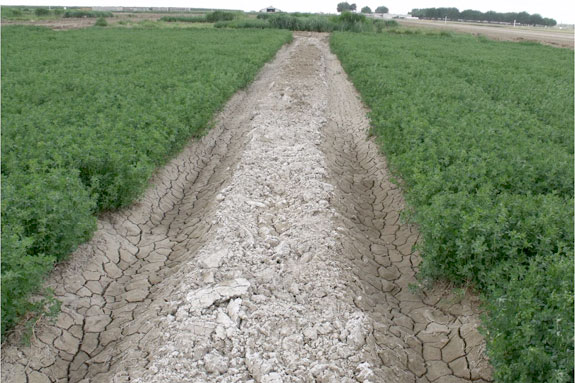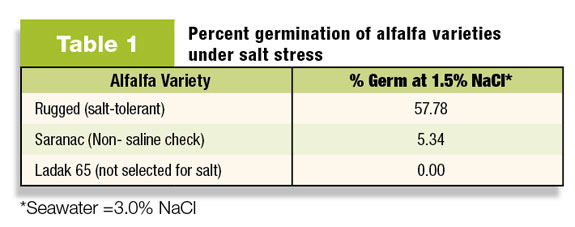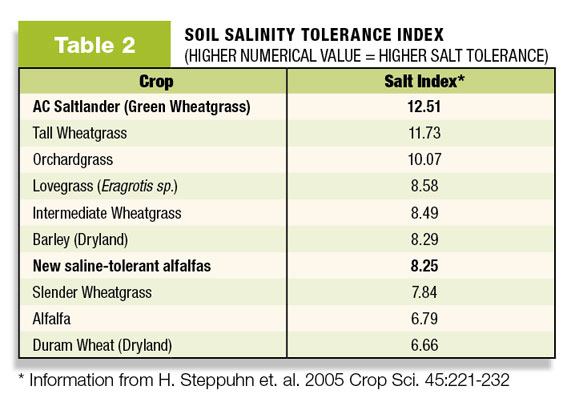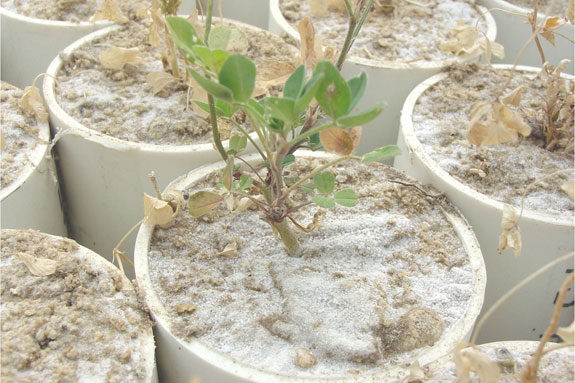Salinity is a growing problem on farmland in many parts of the western U.S., ranging from the Dakotas to the arid Southwest. The increase in salinity in these regions is adversely affecting crop productivity and in some cases making portions of fields unprofitable or unfarmable.
Salinity problems can result from high water tables that bring salts to the surface (saline seeps) or, in arid climates, the salts tend to accumulate on the soil surface due to irrigation combined with high evaporation rates. In irrigated forage production regions, the salinity problem is also increasing as farmers move from flood irrigation to sprinkler irrigation as a means of improving irrigation efficiency.
Sprinkler irrigation applies significantly less water and, as a result, salts stay near the soil surface as compared to flood irrigation which tends to leach the salts down below the root zone.
It has been said that any area utilizing irrigation for crop production will eventually have to deal with increased soil salinity.
Regardless of the cause, the salinity problem appears to be increasing and farmers must learn to effectively manage salinity to remain profitable.
Utilization of improved salt-tolerant forage crops is one new tool that will help farmers maximize production on saline soils and achieve that goal.
Salt-tolerant forages: New tool to combat salinity
The development of new improved salt-tolerant forage crops gives forage producers an additional means of minimizing salinity-related production losses and an opportunity to improve profits by fully utilizing all the farm ground available to them.
Although the new advances in salt-tolerant genetics are a big step in combating salinity losses, producers should not consider it as the sole answer.
Some saline problems are so severe that improved genetics will not solve the salinity problem alone. In those cases, utilizing superior genetics combined with sound soil and water management practices can provide an integrated approach to improving forage yield on both saline and marginally saline soils.
Salinity-related forage yield losses
Production losses due to salinity may occur in several forms. The most visual and obvious yield losses are related to poor stand establishment and/or mature plant stunting.
However, less obvious significant yield losses of 5 to 10 percent may be occurring throughout the overall field and only detectable if yields are compared to comparable non-saline field production.
Even good fields may have saline “hot spots” that are unproductive due to the buildup of salt. Regardless of the severity of the salt problem, there is often a significant portion of affected fields classified as marginally saline – in which planting improved genetics can have an immediate beneficial effect.
New improved alfalfa species
Alfalfa is often called the “Queen of Forages” and well known for its high yield and forage quality. For that reason it has been a logical candidate for the development of salinity-tolerant forage varieties.
Early breeding efforts focused primarily on developing varieties with increased germination under salt stress as a means of improving stand establishment.

The first varietal release, Salado, and later varieties like Rugged and Bullseye displayed significant improvements in germination under salt stress when compared to unselected varieties (Table 1).
Subsequent varietal releases were in the area of improved forage production under salt stress.
The most recent salt-tolerant varieties now combine both germination tolerance and improved forage production under salt stress.
These genetic improvements have proven to be beneficial in marginal saline areas, first by improving stands in “saline hot spots” and later by increasing mature plant salt tolerance in established stands.
This combined approach has resulted in significant forage yield improvements in fields with yield losses due to variable salt stresses.
It should be noted that the newer salt-tolerant varieties also are top-performing varieties in non-saline soils – they just have the additional genetic trait of improved salt tolerance. This combined trait makes them very well-suited to provide maximum yields in variable saline environments.
New saline-tolerant grass
Although alfalfa’s salt tolerance is being improved, there are also other species that have shown potential as salinity-tolerant forages (Table 2).
The newest release with significant salt tolerance was developed from a plant introduction collected in Turkey and recently designated as a new species called “green wheatgrass” (variety name: AC Saltlander).
Developed by Ag Canada, this new variety is now being utilized in Canada and the northern U.S. in saline environments.
Recent public and private testing has shown that a combined approach of planting salt-tolerant alfalfas in water table recharge areas and planting AC Saltlander in the more severe low-lying areas can be an effective long-term solution to reclaiming saline seeps.
This integrated species approach combined with other management techniques has proven to be an effective tool in increasing production in saline-affected farm ground.
Palatability and forage quality of salt-tolerant varieties
Quality testing of both saline-tolerant alfalfa and the new greenwheat grass (AC Saltlander) have not show any indication of a negative effect of salt tolerance on forage quality.
Canada grazing trials of AC Saltlander indicate that the new forage grass is an acceptable feed and has displayed weight gains of 2.9 pounds per day in cattle grazing trials, as compared to 2.2 pounds of gains from bromegrass in the same study.
Selection for improved salt tolerance in alfalfa has not shown any reduction in forage quality.
Advantages of improved salt-tolerant species
1. Improved stand establishment in “saline hot spots.”
2. Minimizes forage yield reductions due to moderate or severe saline stress.
3. Dual-purpose varieties provide top yields in non-saline fields as well as improved performance in marginal saline ground.
4. Salt-tolerant varieties provide another tool in an integrated approach of reclaiming saline soils by combining improved genetics with sound soil and water management practices.
5. Salt-tolerant varieties may minimize the adverse salt effects of manure applications on stand life and forage yield.
6. Higher farm profits by maximizing marginal ground yields.
Summary
The improved salt-tolerant forage crops listed above are just a few examples of varieties that are now available to farmers and ranchers to help minimize the adverse effect of salinity on their farms.
Click here for a complete listing of alfalfa varieties having proven salt tolerance can be found on the National Alfalfa & Forage Alliance (NAFA) website. FG
PHOTOS
TOP: New crops give forage producers an opportunity to improve profits by utilizing all the farm ground available to them.
BOTTOM: Salt accumulation on a border during an alfalfa trial. Photos courtesy of Don Miller.












